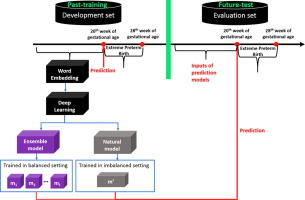Journal of Biomedical informatics ( IF 4.0 ) Pub Date : 2019-10-31 , DOI: 10.1016/j.jbi.2019.103334 Cheng Gao 1 , Sarah Osmundson 2 , Digna R Velez Edwards 3 , Gretchen Purcell Jackson 4 , Bradley A Malin 5 , You Chen 1

|
Objective
Models for predicting preterm birth generally have focused on very preterm (28–32 weeks) and moderate to late preterm (32–37 weeks) settings. However, extreme preterm birth (EPB), before the 28th week of gestational age, accounts for the majority of newborn deaths. We investigated the extent to which deep learning models that consider temporal relations documented in electronic health records (EHRs) can predict EPB.
Study design
EHR data were subject to word embedding and a temporal deep learning model, in the form of recurrent neural networks (RNNs) to predict EPB. Due to the low prevalence of EPB, the models were trained on datasets where controls were undersampled to balance the case-control ratio. We then applied an ensemble approach to group the trained models to predict EPB in an evaluation setting with a nature EPB ratio. We evaluated the RNN ensemble models with 10 years of EHR data from 25,689 deliveries at Vanderbilt University Medical Center. We compared their performance with traditional machine learning models (logistical regression, support vector machine, gradient boosting) trained on the datasets with balanced and natural EPB ratio. Risk factors associated with EPB were identified using an adjusted odds ratio.
Results
The RNN ensemble models trained on artificially balanced data achieved a higher AUC (0.827 vs. 0.744) and sensitivity (0.965 vs. 0.682) than those RNN models trained on the datasets with naturally imbalanced EPB ratio. In addition, the AUC (0.827) and sensitivity (0.965) of the RNN ensemble models were better than the AUC (0.777) and sensitivity (0.819) of the best baseline models trained on balanced data. Also, risk factors, including twin pregnancy, short cervical length, hypertensive disorder, systemic lupus erythematosus, and hydroxychloroquine sulfate, were found to be associated with EPB at a significant level.
Conclusion
Temporal deep learning can predict EPB up to 8 weeks earlier than its occurrence. Accurate prediction of EPB may allow healthcare organizations to allocate resources effectively and ensure patients receive appropriate care.
中文翻译:

深度学习可根据电子健康记录预测极端早产。
客观的
预测早产的模型通常集中在早产(28-32周)和中晚期早产(32-37周)的环境中。但是,在胎龄的第28周之前,极端早产(EPB)占新生儿死亡的大部分。我们调查了考虑电子健康记录(EHR)中记录的时间关系的深度学习模型可以预测EPB的程度。
学习规划
EHR数据经过词嵌入和时态深度学习模型(以递归神经网络(RNN)的形式)来预测EPB。由于EPB的患病率较低,因此在数据集上对模型进行了训练,对数据集进行了抽样不足以平衡病例与对照的比例。然后,我们采用集成方法对训练好的模型进行分组,以在具有自然EPB比率的评估环境中预测EPB。我们使用范德比尔特大学医学中心25,689例分娩的10年EHR数据评估了RNN集成模型。我们将它们的性能与传统的机器学习模型(逻辑回归,支持向量机,梯度提升)进行了比较,这些模型在具有平衡的自然EPB比率的数据集上进行了训练。使用调整后的优势比确定与EPB相关的危险因素。
结果
与在具有自然失衡的EPB比率的数据集上训练的RNN模型相比,在人工平衡的数据上训练的RNN集成模型实现了更高的AUC(0.827对0.744)和灵敏度(0.965对0.682)。此外,RNN集成模型的AUC(0.827)和灵敏度(0.965)优于在平衡数据上训练的最佳基准模型的AUC(0.777)和灵敏度(0.819)。另外,发现高危因素包括双胎妊娠,子宫颈短,高血压疾病,系统性红斑狼疮和羟氯喹硫酸盐。
结论
时态深度学习可以预测EPB比其发生的时间早8周。对EPB的准确预测可以使医疗机构有效地分配资源并确保患者得到适当的护理。











































 京公网安备 11010802027423号
京公网安备 11010802027423号